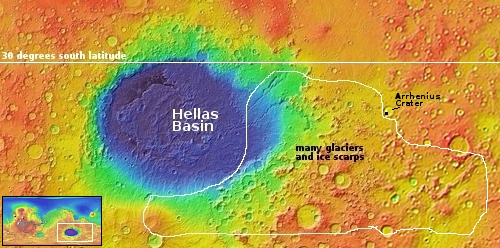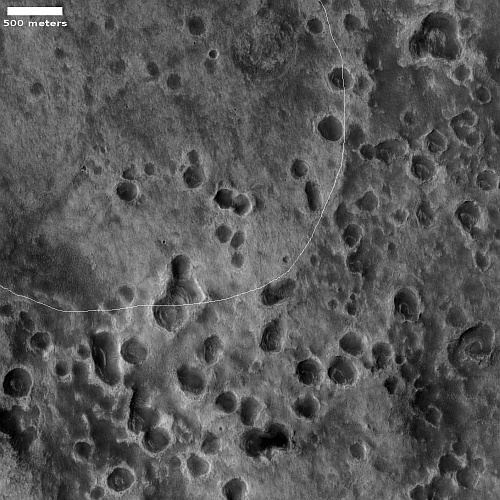A spray of Martian hollows
Cool image time! The photo to the right, rotated, cropped, reduced, and sharpened to post here, was taken on October 12. 2022 by the high resolution camera on Mars Reconnaissance Orbiter (MRO). Dubbed simply as a a “terrain sample” by the science team, the picture was not taken as part of any specific research project, but instead to fill a gap in the orbiter’s shooting schedule so as to maintain the camera’s proper temperature. When MRO’s science team does this, they try to pick something in the area below that might be interesting. Sometimes they succeed, but often the features in the picture are nondescript.
The white line delineates the rim of a faint and very eroded small crater. Are the depressions that are mostly concentrated just to its south and east sinks or past impact craters? I haven’t the faintest idea. The overview map below helps to answer this question, but only partly.

The black dot in the southwest quadrant of 80-mile-wide Arrhenius Crater marks this picture’s location. The inset gives us the global context of this overview map.
Note that this image sits just outside the region where scientists have found many glaciers and ice scarps. The edges of that region are of course not as precise as suggested by the white line, so it is very possible these depressions are sinks formed by the sublimation of near-surface underground ice, similar to the scallops found elsewhere in this region.
At the same time, a different hi-res image in the northeast quadrant of Arrhenius’s floor appears far less icy, suggesting instead that this spray of holes might instead be secondary impacts from a larger impact nearby.
Being on the border of this region appears to make any judgment uncertain. The uncertainty also suggests that we simply don’t yet have enough information about the full extent of Mars’ mid-latitude glacial bands.
On Christmas Eve 1968 three Americans became the first humans to visit another world. What they did to celebrate was unexpected and profound, and will be remembered throughout all human history. Genesis: the Story of Apollo 8, Robert Zimmerman's classic history of humanity's first journey to another world, tells that story, and it is now available as both an ebook and an audiobook, both with a foreword by Valerie Anders and a new introduction by Robert Zimmerman.
The print edition can be purchased at Amazon or from any other book seller. If you want an autographed copy the price is $60 for the hardback and $45 for the paperback, plus $8 shipping for each. Go here for purchasing details. The ebook is available everywhere for $5.99 (before discount) at amazon, or direct from my ebook publisher, ebookit. If you buy it from ebookit you don't support the big tech companies and the author gets a bigger cut much sooner.
The audiobook is also available at all these vendors, and is also free with a 30-day trial membership to Audible.
"Not simply about one mission, [Genesis] is also the history of America's quest for the moon... Zimmerman has done a masterful job of tying disparate events together into a solid account of one of America's greatest human triumphs."--San Antonio Express-News
Cool image time! The photo to the right, rotated, cropped, reduced, and sharpened to post here, was taken on October 12. 2022 by the high resolution camera on Mars Reconnaissance Orbiter (MRO). Dubbed simply as a a “terrain sample” by the science team, the picture was not taken as part of any specific research project, but instead to fill a gap in the orbiter’s shooting schedule so as to maintain the camera’s proper temperature. When MRO’s science team does this, they try to pick something in the area below that might be interesting. Sometimes they succeed, but often the features in the picture are nondescript.
The white line delineates the rim of a faint and very eroded small crater. Are the depressions that are mostly concentrated just to its south and east sinks or past impact craters? I haven’t the faintest idea. The overview map below helps to answer this question, but only partly.

The black dot in the southwest quadrant of 80-mile-wide Arrhenius Crater marks this picture’s location. The inset gives us the global context of this overview map.
Note that this image sits just outside the region where scientists have found many glaciers and ice scarps. The edges of that region are of course not as precise as suggested by the white line, so it is very possible these depressions are sinks formed by the sublimation of near-surface underground ice, similar to the scallops found elsewhere in this region.
At the same time, a different hi-res image in the northeast quadrant of Arrhenius’s floor appears far less icy, suggesting instead that this spray of holes might instead be secondary impacts from a larger impact nearby.
Being on the border of this region appears to make any judgment uncertain. The uncertainty also suggests that we simply don’t yet have enough information about the full extent of Mars’ mid-latitude glacial bands.
On Christmas Eve 1968 three Americans became the first humans to visit another world. What they did to celebrate was unexpected and profound, and will be remembered throughout all human history. Genesis: the Story of Apollo 8, Robert Zimmerman's classic history of humanity's first journey to another world, tells that story, and it is now available as both an ebook and an audiobook, both with a foreword by Valerie Anders and a new introduction by Robert Zimmerman.
The print edition can be purchased at Amazon or from any other book seller. If you want an autographed copy the price is $60 for the hardback and $45 for the paperback, plus $8 shipping for each. Go here for purchasing details. The ebook is available everywhere for $5.99 (before discount) at amazon, or direct from my ebook publisher, ebookit. If you buy it from ebookit you don't support the big tech companies and the author gets a bigger cut much sooner.
The audiobook is also available at all these vendors, and is also free with a 30-day trial membership to Audible.
"Not simply about one mission, [Genesis] is also the history of America's quest for the moon... Zimmerman has done a masterful job of tying disparate events together into a solid account of one of America's greatest human triumphs."--San Antonio Express-News



Mars looks a lot more interesting than the Moon.
I’m not that into sending humans to Mars. Just send 50+ rovers, helicopters, balloons, Roomba’s :-) to Mars. No Life Support systems needed – just a feather duster to clean dust off the solar cells.